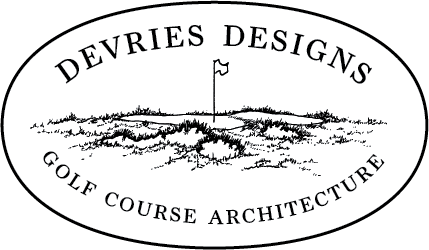Features are the elements that define a golf course's playing area.
They give it distinction and variety, quality, and a uniqueness
that separates one golf course from the next. Each of the following
features can be looked at individually or as a group for how
they fit together and combine to make one cohesive design.
TEES
Diamond Springs / Hole 9
Tees are an important aspect of the golf course because they are the first impression the golfer gets of the golf course and of each individual hole. They also need to be large enough to accommodate many divots in the height of the season. They need to be relatively level so as to provide each golfer with a good start to the hole. And tees need to be provided to accommodate golfers of varying levels of ability.
Most importantly, the teeing area is a controlled view by design. It sets up the strategy and direction that a .golfer must take to execute the hole successfully. .Visual clues can be utilized to direct a golfer towards .or away from certain elements. Some tees may give .a sense of freedom while others may constrict the .golfer's viewpoint through the use of trees, landscape, .or vegetation. Only on the tee is the golfer forced to .assess the hole from the designer's perspective.
Kingsley Club / Hole 4
FAIRWAYS
Fairways provide the main play surface from tee to green and are the most intensively maintained area of the golf course behind greens and tees. Traditional courses often have simpler fairway lines, usually straight down the sides of the hole. This relates to the simpler maintenance of years ago, where there was less definition between fairway and rough. Today, many courses “contour” their fairway cuts into wavy lines to either correspond to differences in contour of the ground or to aesthetically separate the fairway from the rough.
The undulations and strategy of a fairway are most important to DeVries Designs. Creating golf holes that utilize the natural ridges, hollows, and imperfections in the landscape to make the golfer consider his favored path of approach to the green makes for a better golf hole that will change with the elements and playing ability of a golfer at that moment.
GREENS
Mines Golf Course / Hole 11
Greens are the most equalizing and fun part of golf. Every stroke counts the same, but only on the putting surface is every golfer without a handicap because physical strength is not a factor. But mental golf strength will rise to the top and overcome adversity on the putting green. Due to this, Mike DeVries is more likely to develop green-sites with more movement and contour in and around them to challenge golfers and bring out the best in their short game.
With today's technological advancements, green speed has .become the center of heated debate. Fast greens are now .attainable with little or no grain, but often the grass is stressed .from trying to maintain fast speeds for too long. A green with .more contour in it but less speed (due to a higher cut) is fun .for all golfers and less stressful on the grass.
Every golf course project has greens as its number one priority, and appropriately so, as the greens are the facial expressions of the golf course. Half of the game is played on or around the greens and therefore they need to be perfect in concept, execution, and conditioning. DeVries Designs spends an inordinate amount of time to achieve this perfection with every green it works on.
Greywalls / Hole 6
ROUGH
The primary rough is maintained on a regular basis, usually in the range of 1-3 inches, and is sometimes broken down into two or more heights of cut. DeVries Designs believes it is important to provide for good turfgrass in this area, although it shouldn’t be so maintained as to burden the maintenance budget of a course.
Secondary rough can take on many different forms and refers to areas that are left to go “natural” or unmaintained for most of the season. Management of these areas is typically done on an annual or semi-annual program to keep the species consistent over many years and to maintain a grassland habitat.
DeVries Designs strives to create natural areas on most of its courses. Natural areas can distinguish a golf course for its unique environment and can buffer golf holes from each other. It integrates the golf course into the landscape and provides for plant and animal habitat. Golf courses are actively managed landscapes that can utilize the expertise of its turf director to further distinguish what is unique about a site. In some instances, a sanctuary for endangered or threatened species could be developed to ensure the continuance of a plant or animal in a growing area where the land is susceptible to development.





